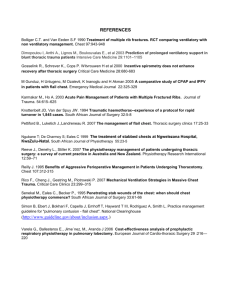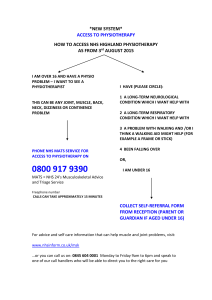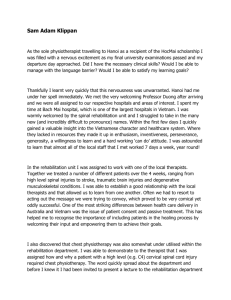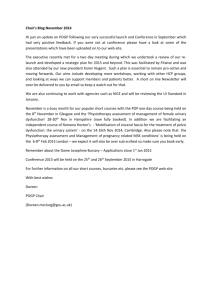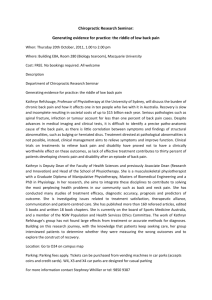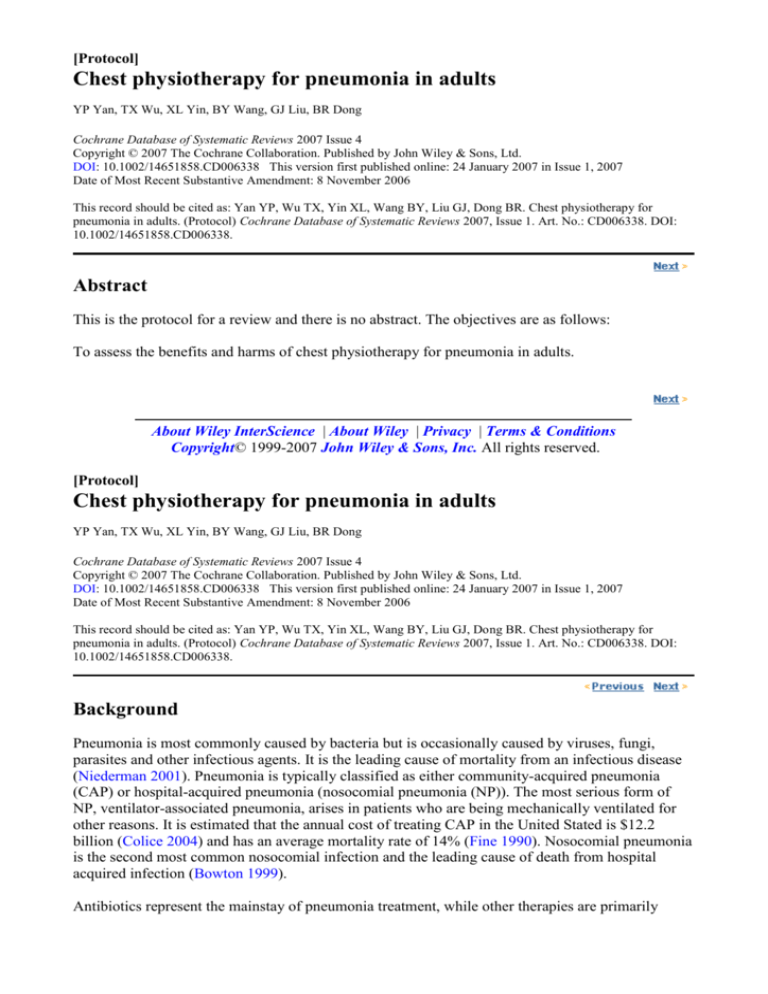
[Protocol]
Chest physiotherapy for pneumonia in adults
YP Yan, TX Wu, XL Yin, BY Wang, GJ Liu, BR Dong
Cochrane Database of Systematic Reviews 2007 Issue 4
Copyright © 2007 The Cochrane Collaboration. Published by John Wiley & Sons, Ltd.
DOI: 10.1002/14651858.CD006338 This version first published online: 24 January 2007 in Issue 1, 2007
Date of Most Recent Substantive Amendment: 8 November 2006
This record should be cited as: Yan YP, Wu TX, Yin XL, Wang BY, Liu GJ, Dong BR. Chest physiotherapy for
pneumonia in adults. (Protocol) Cochrane Database of Systematic Reviews 2007, Issue 1. Art. No.: CD006338. DOI:
10.1002/14651858.CD006338.
Abstract
This is the protocol for a review and there is no abstract. The objectives are as follows:
To assess the benefits and harms of chest physiotherapy for pneumonia in adults.
About Wiley InterScience | About Wiley | Privacy | Terms & Conditions
Copyright© 1999-2007 John Wiley & Sons, Inc. All rights reserved.
[Protocol]
Chest physiotherapy for pneumonia in adults
YP Yan, TX Wu, XL Yin, BY Wang, GJ Liu, BR Dong
Cochrane Database of Systematic Reviews 2007 Issue 4
Copyright © 2007 The Cochrane Collaboration. Published by John Wiley & Sons, Ltd.
DOI: 10.1002/14651858.CD006338 This version first published online: 24 January 2007 in Issue 1, 2007
Date of Most Recent Substantive Amendment: 8 November 2006
This record should be cited as: Yan YP, Wu TX, Yin XL, Wang BY, Liu GJ, Dong BR. Chest physiotherapy for
pneumonia in adults. (Protocol) Cochrane Database of Systematic Reviews 2007, Issue 1. Art. No.: CD006338. DOI:
10.1002/14651858.CD006338.
Background
Pneumonia is most commonly caused by bacteria but is occasionally caused by viruses, fungi,
parasites and other infectious agents. It is the leading cause of mortality from an infectious disease
(Niederman 2001). Pneumonia is typically classified as either community-acquired pneumonia
(CAP) or hospital-acquired pneumonia (nosocomial pneumonia (NP)). The most serious form of
NP, ventilator-associated pneumonia, arises in patients who are being mechanically ventilated for
other reasons. It is estimated that the annual cost of treating CAP in the United Stated is $12.2
billion (Colice 2004) and has an average mortality rate of 14% (Fine 1990). Nosocomial pneumonia
is the second most common nosocomial infection and the leading cause of death from hospital
acquired infection (Bowton 1999).
Antibiotics represent the mainstay of pneumonia treatment, while other therapies are primarily
supportive. These adjunctive therapies include supplemental oxygen, intravenous hydration and
chest physiotherapy (George 1995). Chest physiotherapy is an airway clearance technique that
combines manual percussion of the chest wall by a caregiver, strategic positioning of the patient for
mucus drainage, and teaching cough and breathing techniques. It assists in treating some of the
symptoms of respiratory disorders, such as airflow obstruction, alterations in ventilatory pump
functions and impaired exercise performance. The aim is to improve a patient's respiratory status
and expedite recovery by enhancing airway clearance in lung diseases associated with
hypersecretion and reduced airway resistance. Increased airway clearance enhances gas exchange
and reduces the work of breathing (Wallis 1999). Chest physiotherapy is best used for patients with
copious secretions (more than 30 ml/day) who have a reduced ability to cough (Cochrane 1977;
Graham 1978). However, chest physiotherapy may be ineffective and even harmful. It may cause an
increase in oxygen consumption (Horiuchi 1997; Weissman 1991; Weissman 1993), bronchospasm
(Campbell 1975), induce hypertension, increase oxygen demand (Horiuchi 1997; Weissman 1993),
lead to hypoxaemia (Connors 1980; Poelaert 1991) and even cause rib fractures (Chalumeau 2002).
Chest physiotherapy for cystic fibrosis, acute bronchiolitis and patients being mechanically
ventilated have been reviewed (Flenady 2002; Perrotta 2005; Schans 2000). Schans was not able to
source any robust evidence to support a beneficial or harmful effect of chest physiotherapy in
people with cystic fibrosis (Schans 2000). Perrotta suggested that percussion and vibration
techniques could not be recommended for hospitalised infants with acute bronchiolitis (Perrotta
2005). Flenady concluded that there was inadequate data to assess the benefits and harms associated
with active chest physiotherapy for babies being extubated from mechanical ventilation in neonatal
intensive care settings (Flenady 2002).
The clinical effectiveness of chest physiotherapy for pneumonia is controversial. Some clinical
studies concluded that chest physiotherapy did not hasten the resolution of pneumonia (Graham
1978) or was not useful (Britton 1983; Britton 1985). Two studies suggested that larger or
multicentre trials were needed to confirm the findings (Ntoumenopoulos 2002; Tydeman 1989);
while others concluded that chest physiotherapy had beneficial effects in patients with pulmonary
infection (Hanying 2005). No systematic review or meta-analysis of chest physiotherapy for
pneumonia has been published, to our knowledge. This review aims to systematically review all
randomised controlled trials (RCTs) and controlled clinical trials (CCTs) which examine the
effectiveness of chest physiotherapy for pneumonia.
Objectives
To assess the benefits and harms of chest physiotherapy for pneumonia in adults.
Criteria for considering studies for this review
Types of studies
We will consider all RCTs assessing the efficacy of chest physiotherapy for adult patients with any
type of pneumonia. Trials which also include other basic respiratory diseases will be included if
pneumonia is diagnosed; such trials will be analysed separately. We will exclude the trials in which
physiotherapy is administered for prevention of pneumonia, as pneumonia can occur in many
conditions, such as trauma, cerebral vessels disease, postoperative conditions, and so on. Quasirandomised controlled trials will also be considered. Both published and unpublished trials will be
included.
Types of participants
Adult patients (older than 18 years of age) of either gender, with any type of pneumonia.
Pneumonia will be defined by each original trial. The diagnostic criteria used by the trial authors
will be described in the 'Characteristics of Included Studies' section of the review.
Types of intervention
Chest physiotherapy of any type compared to no chest physiotherapy. We will include trials using
traditional chest physiotherapy. Trials using mechanical devices which have the same effect as
traditional chest physiotherapy will also be included. These methods will be considered: postural
drainage, chest percussion, vibration, thoracic oscillation, chest shaking, huffing, directed coughing,
thoracic expansion, forced exhalation or expiration techniques and manual hyperinflation.
Types of outcome measures
Primary outcomes
1. Death;
2. Cure rate (proportion of the number of clinically cured patients of the total number of patients).
Secondary outcomes
1. Duration of hospital stay (days);
2. Healing time (days);
3. Rate of clearing of X-ray film;
4. Fever clearance time.
Adverse events
We will define serious adverse events, according to the ICH Guidelines (CFR & ICH 1997), as any
event that: leads to death, is life-threatening, requires in-patient hospitalisation or prolongation of
existing hospitalisation, results in persistent or significant disability; or any important medical event
which may have jeopardised the patient or requires intervention to prevent it. All other adverse
events will be considered non-serious.
Search methods for identification of studies
See: Cochrane Acute Respiratory Infections Group methods used in reviews.
We will search the following databases the Cochrane Central Register of Controlled Trials
(CENTRAL) (The Cochrane Library latest issue); MEDLINE (1966 to present); EMBASE (1974 to
present); CBMdisc (1978 to present); the National Research Register (www.updatesoftware.com/National/nrr-frame.html); and Physiotherapy Evidence Database (PEDro).
The following search terms will be used in MEDLINE in conjunction with the highly sensitive
search strategy suggested in the Cochrane Handbook for Systematic Reviews of Interventions 4.2.5
(Higgins 2005) for identification of RCTs. These terms will be modified as appropriate for other
databases. We will also handsearch related journals and references of included studies. There will
be no language restrictions.
(exp Pneumonia/ OR pneumonia$ OR lung inflammation$ OR exp Respiratory Tract Infections/
OR respiratory tract infection$ OR respiratory infection$)
AND
(exp Physical Therapy Modalities/ OR physical therap$ OR physiotherapy$ OR physical treatment$
OR exp drainage, postural/ OR postural drainag$ OR chest clap$ OR chest percussion OR chest
shak$ OR oscillati$ OR exp vibration/ OR vibration OR directed cough$ OR forced exhalation OR
forced expiration OR exp Positive-Pressure Respiration/ OR positive pressure ventilation OR
positive expiratory pressure OR exp breathing exercises/ OR breathing exercise$ OR diaphragmatic
breathing OR thoracic expansion exercise$ OR breathing train$ OR ventilatory muscle train$ OR
exp Electric Stimulation Therapy/ OR electrostimulation OR huff$ OR exp massage/ OR massag$
OR exp musculoskeletal manipulations/ OR hyperinflation).
Methods of the review
The contact author will search the literature and two review authors will independently assess the
extracted titles and abstracts to identify potentially relevant articles. We will exclude the trials
which fail to meet the inclusion criteria. Differences will be resolved by a third review author.
Quality assessment of trials
The quality of the trials will be assessed independently by two review authors, based on the
generation of the allocation sequence, allocation concealment, blinding and follow up. Finally, we
will assess the risk of bias, where A: low risk of bias (all of the criteria met); B: moderate risk of
bias (one or more criteria partly met); C: high risk of bias (one or more criteria not met).
Differences will be resolved by another review author.
The detailed quality components are as follows:
• Generation of the allocation sequence:
Adequate (computer generated random numbers, table of random numbers, or similar);
Unclear (the trial was described as randomised, but the generation of the allocation sequence was
not described);
Inadequate (quasi-randomised trials; non- randomised trials).
• Allocation concealment:
Adequate (concealed up to the point of treatment by central randomisations, sealed envelopes, or
similar);
Unclear (the allocation concealment procedure was not described);
Inadequate (open table of random numbers or similar).
• Blinding:
Adequate (since the intervention of chest physiotherapy can't be completely masked, it will be
impossible to have double-blinding. We will consider single-blinding adequate);
Unclear (if the method of blinding was not described);
Not performed (if the trial was not blind).
• Follow up:
Adequate (if the numbers and reasons for dropouts and withdrawals in all intervention groups are
described or specified that there were no dropouts or withdrawals);
Unclear (if the report gave the impression that there had been no dropouts or withdrawals, but was
not specifically stated);
Inadequate (if the number or reasons for dropouts and withdrawals are not described).
Data extraction
Data will be independently extracted by two review authors using a standardised form. We will
attempt to contact all trial authors (by e-mail, letter or fax) for additional papers, to confirm data
extraction, and to obtain missing data. After completion of the data extraction, the data will be
checked by another review author. Pertinent data to be extracted will include, where possible:
description of participants (including age, gender, type of pneumonia, severity of pneumonia, basic
conditions, setting); description of intervention (details of chest physiotherapy, including type,
frequency, intensity, time); description of control therapy; trial design (including design,
recruitment, method of randomisation, sample size, trial inclusion and exclusion criteria,
withdrawals); description of outcomes (including mortality, duration of hospital stay, adverse
events, cure, healing time, rate of clearing of X-ray film, duration of fever); and source of funding.
Data analysis
Any dichotomous data, such as the cure rate or mortality, will be expressed as a relative risk
together with a 95% confidence interval (CI). Data for continuous measures will be expressed either
as a mean difference (MD) (95% CI) or a standardised mean difference (SMD) (95% CI). The MD
will be used if all trials provide data on the same scale, if not the SMD will be used. If a number of
trials are available with sufficient uniformity in settings and outcome definitions, we will attempt to
pool results by meta-analysis; but if the trials are relatively dissimilar, either statistically or
clinically, they will be presented separately. Trials will be combined using Review Manager
(Version 4.2.8). A fixed-effect model will be used unless significant heterogeneity is noted, then a
random-effects model will be chosen. Heterogeneity in trial results will be assessed by inspecting
the forest plots to detect overlapping CIs, applying the chi-squared test with a p-value of 0.10
indicating statistical significance, and implementing the I-squared test (with a value of 50% used to
denote moderate levels of heterogeneity). In case of heterogeneity between the studies, efforts will
be made to explore sources of heterogeneity due to various factors such as type of pneumonia, type
of physiotherapy, and so on. We will graphically check for publication bias by using a funnel plot.
Subgroup analyses will be performed, where possible, for the following: age category, different
type of chest physiotherapy, different type of pneumonia, and disease severity.
Sensitivity analyses
We will perform sensitivity analyses in order to explore the influence of the following factors on
effect size:
1. Repeating the analysis excluding unpublished studies (if there were any);
2. Repeating the analysis taking account of study quality; for example, RCTs with poor
methodology;
3. Repeating the analysis excluding studies using any of the following filters: diagnostic criteria,
language of publication, source of funding (industry versus other) or country.
Potential conflict of interest
None known.
Acknowledgements
Thank you to Elizabeth Dooley, Review Group Co-ordinator for the Cochrane Acute Respiratory
Infections Group, for help with writing this protocol; and Ruth Foxlee, Trials Search Co-ordinator
for the Cochrane Acute Respiratory Infections Group, for her useful comments on the search
strategy. Thank you to the Statistical Editor (Nelcy Rodriguez), Contact Editor (Abigail Fraser),
Peer Referees (Jan Poelaert and George Ntoumenopoulos) and Consumer Referees (Mona Nasser
and Anne Lyddiatt) of this protocol for their useful comments.
Sources of support
External sources of support
• No sources of support supplied
Internal sources of support
• Chinese Cochrane Center, Chinese Centre of Evidence-Based Medicine, West China Hospital of
Sichuan University CHINA
Cover sheet
Title
Chest physiotherapy for pneumonia in adults
Author(s)
Yan YP
Wu TX
Yin XL
Wang BY
Liu GJ
Dong BR
Contribution of
author(s)
Yuping Yan (YY) and Taixiang Wu (TW) wrote the protocol. Birong
Dong (BD) provided speciality consultation. Xiangli Yin (XY) and
Binyou Wang (BW) searched for relevant articles. Gunajian Liu (GL)
was consulted regarding data analysis.
Issue protocol first
published
2007 Issue 1
Date of most recent
amendment
November 14, 2006
Date of most recent
SUBSTANTIVE
amendment
November 8, 2006
Contact address
Dr Birong Dong
West China Hospital, Sichuan University
Clinical Epidemiology
No. 37, Guo Xue Xiang
Chengdu
Sichuan
CHINA
610041
E-mail: birongdong@hotmail.com
Tel: +86 28 85422324
DOI
10.1002/14651858.CD006338
Cochrane Library
number
CD006338
Editorial group
Cochrane Acute Respiratory Infections Group
Editorial group code
HM-ARI
About Wiley InterScience | About Wiley | Privacy | Terms & Conditions
Copyright© 1999-2007 John Wiley & Sons, Inc. All rights reserved.


